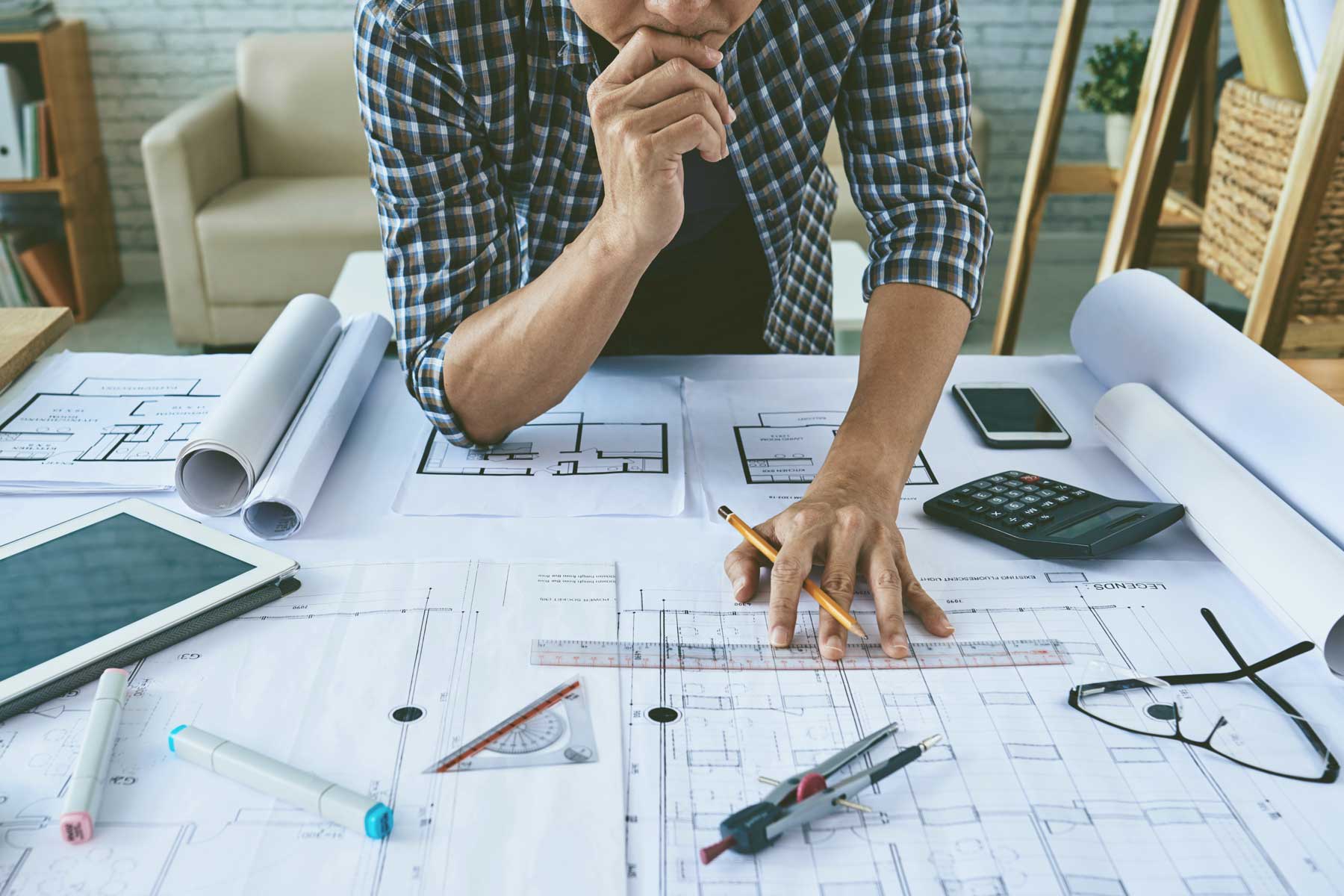Architect Services Clarified: What to Expect from Start to Finish
Architect Services Clarified: What to Expect from Start to Finish
Blog Article
Understanding the Diverse Job Paths Available for Aspiring Architect
As an ambitious Architect, you have a globe of profession paths waiting for you. Whether you're attracted to standard style or the subtleties of lasting style, there's a niche that aligns with your rate of interests.
Typical Design: Designing Frameworks and structures
Conventional design focuses on creating buildings and structures that mix performance with aesthetic appeal. As you discover this field, you'll appreciate the complex balance in between type and function. You'll discover to attract ideas from historical designs, incorporating elements like symmetry, products, and workmanship. Your layouts can show cultural heritage, showcasing neighborhood practices while meeting modern-day needs.
You'll create skills in composing, model-making, and website analysis, allowing you to visualize and communicate your ideas properly. Involving with customers, you'll require to understand their vision and equate it right into viable designs.
In addition, developing codes and sustainability methods are vital in your job, ensuring your frameworks are secure and eco-friendly. As you grow in your job, you'll discover opportunities in residential, commercial, or even restoration jobs, each offering special challenges. Accepting traditional architecture leads the way for a fulfilling profession that pays tribute to the past while shaping the future.
Urban Preparation: Forming Neighborhoods and Public Spaces
As an aspiring Architect, you can play a necessary role as a metropolitan planner, changing just how neighborhoods interact and operate. By employing area involvement techniques, you'll ensure that citizens have a voice in forming their atmosphere. Plus, incorporating lasting layout concepts will aid develop rooms that not just satisfy today's demands however likewise safeguard the future.
Duty of Urban Planners
While lots of may believe of engineers as the sole enthusiasts behind buildings, metropolitan organizers play an essential function in shaping the more comprehensive landscape of communities and public rooms. By collaborating with different stakeholders, you'll aid create parks, transportation systems, and domestic areas that promote social communication and availability. Your competence in spatial layout and community characteristics permits you to picture future growth while maintaining cultural heritage.
Area Interaction Methods
Effective area involvement approaches are essential for urban organizers to guarantee that the voices of homeowners are heard and valued in the planning process. To foster purposeful discussion, you must prioritize open discussion forums and workshops where area participants can reveal their ideas and concerns. Use surveys and social networks to get to a broader target market, guaranteeing varied perspectives are consisted of. Collaborating with local organizations can improve trust fund and assist in deeper links. It is necessary to offer clear details regarding proposed tasks and decision-making procedures, enabling homeowners to feel educated and empowered. By actively listening and including responses, you'll create spaces that show the neighborhood's requirements, ultimately bring about even more successful and sustainable metropolitan settings. Welcome openness and continuous discussion for lasting impact.
Sustainable Style Concepts
When designing metropolitan areas, including lasting layout concepts is important for creating atmospheres that flourish both environmentally and socially. You should begin by concentrating on energy effectiveness, making use of materials that reduce waste and promote recycling. Consider integrating eco-friendly areas, like parks and yards, to improve biodiversity and boost air top quality. Promoting walkability and public transportation can lessen dependence on automobiles, cultivating a healthier community.
Creating with water conservation in mind is also vital-- think of rainfall gardens and permeable surfaces to take care of stormwater. Involving community participants during the planning process guarantees that the areas you develop meet their needs and motivate social communication. By welcoming these principles, you'll add to dynamic, sustainable metropolitan landscapes that benefit everyone.

Landscape Style: Producing Lasting Exterior Settings
As you check out landscape style, you'll discover crucial style principles that produce useful and gorgeous outdoor areas. Sustainable techniques play a vital role in making sure these atmospheres thrive while reducing environmental impact. Plus, you'll find a range of profession chances that permit you to make a real distinction in just how people connect with nature.
Style Principles in Landscape
Understanding design principles in landscape design is crucial for developing lasting exterior settings that harmonize with nature. You'll require to ponder aspects like proportion, balance, and scale to guarantee your styles really feel natural and welcoming. Additionally, pay interest to seasonal modifications, making with products that match the environments year-round.
Lasting Practices Overview
Lasting practices in landscape design not only focus on appearances but also focus on environmental wellness and source preservation. You can create rooms that advertise soil health, such as using natural materials and exercising permaculture principles. Inevitably, these techniques guarantee your layouts benefit both individuals and the setting for years to come.
Career Opportunities Expedition
With a strong foundation in sustainable methods, landscape style provides a variety of job courses that allow you to make a meaningful influence on the environment. You can work as a landscape designer, creating cosmetically pleasing and useful exterior areas, or specialize in environmental reconstruction, assisting to revitalize damaged ecological communities. Urban planners commonly work together with landscape engineers to develop eco-friendly spaces in metropolitan setups, improving city livability. If you're passionate about education and learning, consider ending up being a landscape design teacher, motivating future generations. In addition, you could work with nonprofits concentrated on environmental sustainability or engage in research to introduce brand-new techniques. Each course not just forms stunning atmospheres yet also cultivates a much healthier planet for future generations.
Lasting Layout: Focusing on Eco-Friendly Practices
As you explore your occupation in design, welcoming eco-friendly practices can establish you apart in a competitive area. Sustainable style concentrates on creating buildings that reduce ecological effect while enhancing owner health. By integrating sustainable materials, energy-efficient systems, and sustainable structure strategies, you'll add to a greener future.
Start by acquiring knowledge of green qualifications like LEED or BREEAM, which can strengthen your credentials. Think about exactly how all-natural light, ventilation, and thermal performance can optimize style. Team up with engineers and ecological professionals to innovate remedies that decrease waste and conserve sources.
Don't more info neglect the relevance of neighborhood participation-- interesting local stakeholders can inspire designs that integrate with the setting. As clients increasingly prioritize sustainability, your expertise in environmentally friendly techniques will not just draw in jobs however likewise meet your passion for responsible architecture. Accept this vital aspect of the occupation, and enjoy your career thrive.
Historical Preservation: Shielding and Recovering Social Heritage
While you begin on your building journey, consider the important duty of historic conservation in preserving our social heritage. This area concentrates on the defense and remediation of substantial structures, websites, and frameworks that tell the tales of our past. By participating in historic conservation, you'll aid guard the building legacy that forms area identity.
As a historical preservation Architect, you'll evaluate historic value and analyze the problem of frameworks. You'll function closely with historians and preservationists to ensure authentic repair strategies are employed. This job course enables you to mix imagination with study, enabling you to create remedies that respect initial products and craftsmanship.
Your job not only adds to sustainability by reusing existing buildings yet also promotes a sense of satisfaction within areas. Welcoming this path will certainly aid you come to be a guardian of history, maintaining the stories and aesthetics that improve our lives.
Inside Architecture: Enhancing Indoor Spaces
Historical conservation and indoor design both share a dedication to boosting the built environment, but they concentrate on different elements. While historical conservation highlights keeping a framework's social and historic value, interior architecture nos in on optimizing indoor rooms for capability and aesthetic appeals.
As an ambitious Architect, you'll locate that interior architecture allows you to blend creative thinking with technological skills. You'll design rooms that not just look great but additionally promote convenience and efficiency. This area includes recognizing just how light, shade, and products interact within a space, affecting mood and usability.
You'll work on various jobs, from residential homes to industrial workplaces, making sure that each atmosphere satisfies the requirements of its owners. By focusing on individual experience, you can change insides right into useful and motivating areas, making a considerable influence on exactly how individuals engage with their surroundings. Welcome the possibility to improve indoor settings and shape the means people live and work.
Industrial Style: Merging Performance With Aesthetics
Industrial style plays a crucial role in creating items that seamlessly mix visual appeals with performance, ensuring that what you utilize daily is not only aesthetically enticing but also useful. As an aspiring Architect, you could engage yourself in this field, concentrating on making whatever from furniture to customer electronics. Your job entails recognizing user needs, materials, and producing processes, permitting you to produce innovative solutions that improve daily experiences.
In commercial design, you'll frequently collaborate with marketing professionals, makers, and designers, making sure that your styles are not only attractive but likewise feasible. You'll discover to stabilize form and function, prioritizing use without sacrificing style. By refining your skills in laying out, 3D modeling, and prototyping, you'll be well-equipped to bring your concepts to life. This job path supplies a dynamic atmosphere where imagination satisfies practicality, making it a fulfilling selection for designers thinking about forming the products of tomorrow.
Often Asked Inquiries
What Educational Certifications Do I Required to Come To Be a Designer?
To end up being an engineer, you'll need a specialist degree in design, normally a Bachelor's or Master's. In addition, you'll need to finish an internship and pass the Architect Registration Evaluation to practice lawfully.
Are There Certification Needs for Different Building Profession Paths?
Yes, there're qualification needs for various building paths. Architect. You'll need to pass exams, total internships, and often go after specialized training, depending upon your selected focus, like landscape design, urban style, or historical conservation
What Software Skills Are Important for Engineers Today?

Exactly How Can I Gain Practical Experience While Researching Style?
You check here can acquire practical experience by interning at architectural companies, joining style competitions, volunteering for neighborhood tasks, or teaming up with classmates on real-world assignments. These chances boost your skills and develop valuable connections in the market.
What Task Opportunities Exist Outside Conventional Style Firms?
You can discover different work chances outside standard design firms, like urban planning, indoor layout, landscape architecture, construction management, realty development, and even roles in sustainability consulting. Each offers special difficulties and benefits.
Whether you're attracted to traditional architecture or the nuances of lasting layout, there's a specific niche that lines up with your interests.When creating metropolitan spaces, incorporating lasting style principles is important for developing settings that prosper both environmentally and socially.As you explore landscape style, you'll find essential design principles that develop functional more info and gorgeous outside areas.Recognizing design principles in landscape architecture is important for creating lasting exterior environments that harmonize with nature.In industrial design, you'll commonly work together with producers, engineers, and marketing professionals, guaranteeing that your layouts are not just attractive but additionally feasible.
Report this page